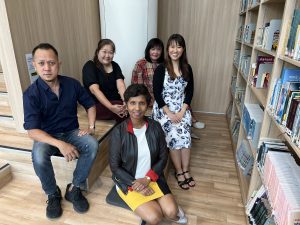Why Singapore’s English Teachers Should Embrace Singlish, Not Fight It
Is it time for Singaporean educators to embrace Singlish as a legitimate learning tool? What the Research […]
Read More
Contributed by Tan Yen Chuan, Centre for Pedagogical Research and Learning, Raffles Girls’ School (Secondary), for SingTeach Virtual Staff Lounge
Blended learning has become the “new traditional model” (Ross & Gage, 2006, p.157) and as teachers tried out different blended learning models, teachers were asking questions such as, “How should we respond if our students do not complete their assignments using flipped classroom?” and “What does a good blended lesson look like?”
In this article, Tan Yen Chuan, from the Raffles Girls’ School Centre for Pedagogical Research and Learning (PeRL), shares some insights on how to prepare for a school-wide adoption of blended learning approach as well as addresses some common challenges faced by teachers.

The team comprises (from left) Azahar Noor, Tan Yin Lai, Mary George Cheriyan, Lucille Yap, Tan Yen Chuan and Masturah Abdul Aziz (not in picture).
The study on teachers’ perception on the use of blended learning is based on a widely cited definition which prescribes blended learning as a pedagogical approach that integrates the strengths of face-to-face and online instruction (Graham, 2006, 2013). Below are some recommendations on enhancing teacher’s competencies on the use of blended learning.
It is important to gain an understanding of the teacher’s readiness and understanding towards blended learning as their dispositions will affect their design of the blended learning lessons, which in turn will impact the learning outcomes. In this study, a Blended Teaching Readiness Survey by Graham et al. (2019) was administered to all teachers. The teachers’ responses allowed the investigators to gain broad insights into teachers’ dispositions, technology skills and their perceptions towards the competencies for effective blended teaching.
Coupled with this, teachers’ experience and opinions about using the blended learning approach were collected through focus group discussions (FGDs). Lesson observations were conducted to obtain snapshots of how teachers have implemented blended learning pedagogy in the classroom.
Based on the FGDs, the most commonly used blended learning model was the Flipped Classroom Model, which saved lesson time as students were given articles to read and materials to learn before attending class. The Station Rotation Model was also used for collaborative learning, online learning and teacher’s instruction in small groups.
While the flipped classroom model helps to deliver a more personalized learning experience for students, some teachers noticed that some students lack the self-discipline to engage with the instructional content in their own time before doing tasks in class.
The benefits of using flipped classroom model will not be achieved if lesson time was used to revise the flipped classroom materials instead of extending the learning for deeper understanding or for clarity, so this highlights the importance of purposeful planning.
Purposeful thinking undergirds the planning of blended learning. Although there is no single method for planning a blended learning lesson, teachers must consciously combine online instruction with in-person instruction into the lesson design. In planning to facilitate online interaction with and between students, teachers must ensure that students should have some element of control over their time, place, goals, learning pace and/or path (Graham, 2019; Staker & Horn, 2012). In addition, support systems to develop student agency must also be provided. For example, to monitor students’ participation rate and progress, teachers should use the data on online platforms to track students’ activity and monitor their performance.
Furthermore, teachers can use technology to give timely feedback and monitor students’ progress, such as milestone checks and auto-marking features in the Student Learning Space (SLS) or Classkick application. The latter can flip the content into an online learning station in class, while others can move on to other learning stations to do more challenging tasks. This strategy is known as in-class flip (Tucker et al, 2016).
Lastly, there should be a shared vision among school members for the adoption of a whole-school approach to blended learning. Teachers must have a common understanding of what blended learning is, its role in this digital age and use the metalanguage in their daily conversations and/or dialogues. The teachers must believe in this approach and facilitate student empowerment and ownership of learning, by making the relevant skills and knowledge explicit and accessible to students.
In order to nurture self-directed learners in a highly connected world, teachers will have to plan to provide for personalized learning; to give more autonomy to students, create more collaborative opportunities using technologies and harness data to provide timely feedback and optimize learning. The school will have to continue to ensure the purposeful design of blended learning in the curriculum and set the desired standards by conducting professional development clinics, providing design guidelines and giving feedback to unit designers.
References
Graham, C. R. (2006). Blended learning systems: Definition, current trends, and future directions. In C. J. Bonk & C. R. Graham (Eds.), Handbook of Blended Learning: Global Perspectives, local designs (pp. 3–21). San Francisco, CA: Pfeiffer.
Graham, C. R. (2013). Emerging practice and research in blended learning. In M. G. Moore (Ed.), Handbook of distance education (3rd ed., pp. 333–350). New York, NY: Routledge.
Graham, C.R., Borup, J., Pulham, E. B., & Larsen, R. (2019). K-12 Blended Teaching Readiness: Model and Instrument Development. Journal of Research on Technology in Education, 51(3), 239-258.
Ross, B., & Gage, K. (2006). Global perspectives on blended learning. In C. J. Bonk & C. R. Graham (Eds.), The Handbook of Blended Learning: Global Perspectives, Local Designs (pp. 155–167). San Francisco: Pfeifer Publishing.
Staker H., Horn M.B. (2012). Classifying K-12. Blended Learning. Available at: http://www. christenseninstitute.org/wp-content/uploads/2013/04/Classifying-K-12-blended-learning.pdf (accessed 20.08.2021).
Tucker, C. R., Green, J. T., & Wycoff, T. (2016). Blended Learning in Action: A Practical Guide Toward Sustainable Change. SAGE Publications.